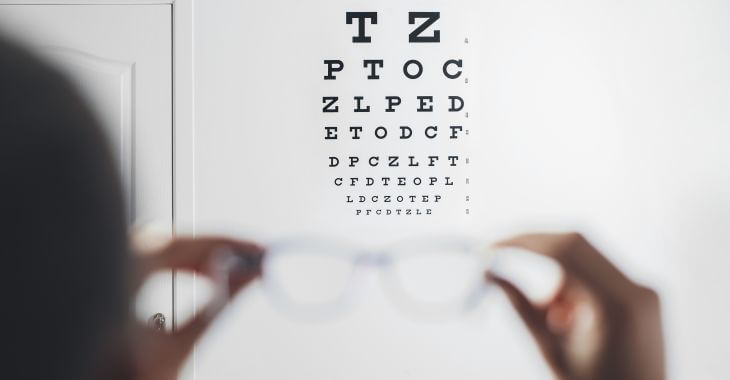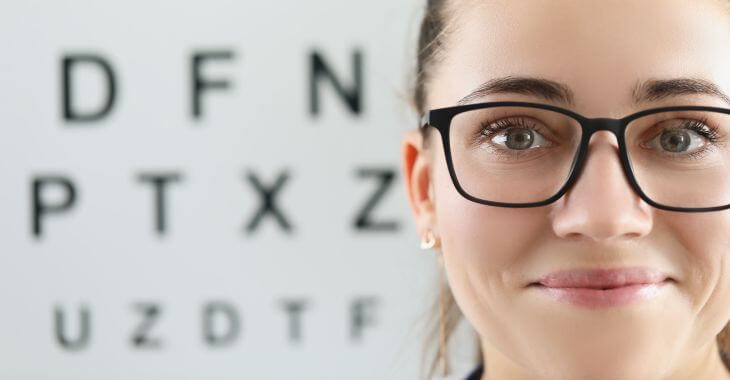What Does 20/40 Vision Mean?

When you get an eye exam, your doctor will measure and evaluate your vision. Not everyone is knowledgeable about what is considered good or poor vision. While you may have heard of 20/20 vision, many people do not know what 20/40 vision means. Here is what you need to know about vision measurement.
If you are told you have 20/40 vision, this might not mean much to you. You are not alone. Many people do not know what the numbers associated with vision indicate. What does 20/40 vision mean? To understand the diagnosis, first you need to know what each set of numbers measures.
Measuring Your Visual Acuity
When you have an eye exam, your doctor will likely begin with having you read the Snellen eye chart. This is a very familiar chart, starting with a large letter at the top and each additional row of letters becoming smaller. This simple chart is used to determine how well you can see from a distance of 20 feet.
When you hear 20/20 or 20/40 vision, the first 20 refers to a 20-foot distance. What can you see from a 20-foot distance? Those with 20/20 eyesight can see what most people without eyesight correction can see at a distance of 20 feet. While this is not “perfect” vision, it is a common vision correction goal.
So, if 20/20 vision means you can see what most people without glasses see at 20 feet, what does 20/40 vision mean? In vision terms, 20/40 vision is slightly nearsighted. This measurement means you can see items at 20 feet that others without eyesight correction can see at 40 feet.
While 20/40 vision is not perfect, there are much higher levels of nearsightedness, up to legal blindness. 20/200 and beyond is considered legally blind, meaning a person cannot see items at 20 feet that “normal” sighted persons see at 200 feet, even with eye correction devices.
Do People with 20/40 Vision Need Glasses?
When you are diagnosed with 20/40 vision, this means you are slightly nearsighted. You have a harder time seeing items farther away than people with 20/20 or 20/10 vision. For example, reading road signs can be more difficult, especially if the font is smaller. But does this mean you need glasses?
One of the indicators that people need glasses is driving. To get your driver’s license, you must pass an eye exam. According to the American Academy of Ophthalmology, most states will issue a driver’s license to those with 20/40 vision. This means those who are slightly nearsighted may not need corrective lenses to drive.
Even though it may not be legally required to wear glasses to drive, many of those with slight nearsightedness prefer to wear glasses or contacts. It can be easier to see things farther away, which can be important in many professions, leisure activities and for personal vision enjoyment.
Nearsighted vs Farsighted
If you have 20/40, 20/70 or higher vision, you are considered nearsighted. You have a more difficult time seeing items that are further away than someone who has 20/20 or 20/10 vision, or those that are farsighted. But you may be able to see things that are close better than someone that is farsighted.
Just because someone has 20/20 or 20/10 vision, it does not mean they see better than someone with 20/40 vision. They can still be farsighted, which makes it hard to read small print or focus on items close to them. Farsighted people may need to wear glasses to read books, screens or labels.
What Is 20/40 Vision in Refractive Error?
When you receive your eye exam results, you will see your visual acuity, such as 20/40 vision for each eye and your refractive error. This is a positive (+) or negative (-) number. 0.0 is considered good vision, and any number that is positive or negative indicates a level of nearsightedness (-) or farsightedness (+).
For those with 20/40 vision, the refractive error would be -1.0. This is considered mild nearsightedness. Numbers positive or negative .25-2.00 are considered mild vison impairments, 2.25-5.0 is moderate impairment, and 5.0 and beyond are severe vision impairments.

Glasses or contacts can correct 20/40 vision closer to 20/20 or 0.0. It is unlikely that someone with 20/40 vision would ever seek laser eye surgery to correct their vision, as this is a very mild form of nearsightedness. Your eye doctor can make recommendations for treatment if needed.
If you have 20/40 vision, you are considered within the normal range of visual acuity. Many people with moderate to severe nearsightedness are only able to achieve 20/40 vision by wearing corrective glasses or contacts. To learn more about what your vision acuity means, talk to your optician, optometrist or ophthalmologist.
The information provided on this website, including text, graphics, images, and other materials, is intended solely for informational purposes and should not be used as a substitute for professional medical advice, diagnosis, or treatment.




)